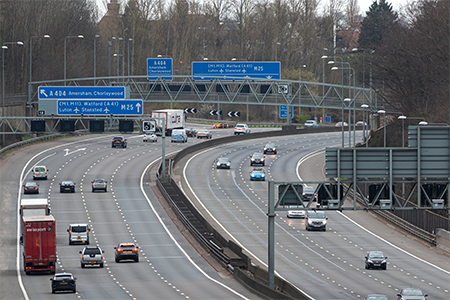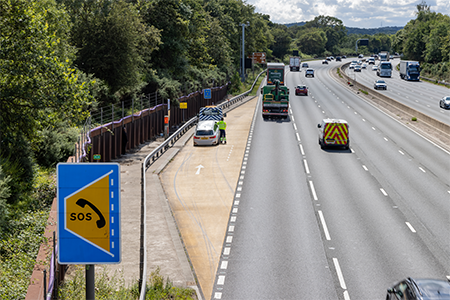What is a Smart Motorway?

As of May 2024, there are 44 operational or under-construction Smart Motorway sections across 14 motorways in England. These are concentrated on major routes like the M1, M6, and M25, where congestion is most common. However, there’s been a significant development since 2016: the government halted construction of new smart motorways in April 2023. This decision came after safety concerns were raised by drivers and motoring organisations.
While existing smart motorways remain operational, it’s important to be aware of the latest updates:
- Focus on Safety: Following public concerns, a £900 million investment was announced in 2024 to improve safety on existing smart motorways. This includes adding more emergency refuge areas (over 150 planned) and improved Stopped Vehicle Detection (SVD) technology to quickly identify breakdowns in live lanes.
- Speeding Fines: While specific data isn’t available for 2024, speeding fines on smart motorways likely remain common due to variable speed limits enforced by overhead gantries.
If you’re unsure about how smart motorways work, don’t worry! The core functionalities remain the same:
- Variable Speed Limits: These adjust traffic flow and improve safety by adapting to congestion.
- Dynamic Lane Management: The hard shoulder may be converted into a running lane during peak times to increase capacity.
- Overhead Signalling: Electronic signs provide clear information on speed limits, lane closures, and other important updates.
By understanding these features, you can navigate smart motorways safely and efficiently.
What is a Smart Motorway and why do we have them?
Highways England (formerly Highways Agency) continues to champion Smart Motorways as a way to manage congestion on England’s motorways. While the initial rollout faced criticism, recent improvements and a shift in focus have led to a renewed effort to make them safer and more reliable.
One key goal of Smart Motorways is to boost capacity and ease congestion. This is achieved by:
- Opening the hard shoulder to traffic: this provides more lanes for flowing traffic during peak periods. However, the closure of the hard shoulder on some stretches has raised safety concerns, leading to a halt in new Smart Motorway construction in April 2023. The government is focusing on improving safety features on existing Smart Motorways before potentially resuming construction in the future.
- Variable speed limits: These adjust dynamically based on traffic conditions, aiming to reduce stop-start driving and create a smoother flow.
Technology for Safety and Efficiency
Smart Motorways utilise various technologies to improve safety and traffic flow:
- Stopped Vehicle Detection (SVD): This system, implemented in September 2022, automatically detects stopped vehicles in live lanes and triggers warnings for approaching drivers.
- Overhead electronic signs: These communicate speed limits, lane closures, and other vital information to drivers.
- CCTV cameras: These monitor traffic flow and help identify incidents for quicker response.
Types of Smart Motorways
Believe it or not, there are actually three types of Smart Motorways: controlled motorways, dynamic hard shoulder running schemes and all-lane running schemes.
Controlled Motorways
This type of Smart Motorway has three or more lanes with variable speed limits, but always has the hard shoulder clear for genuine emergencies only.
Dynamic hard shoulder
Possibly the most commonplace Smart Motorway type, dynamic hard shoulder motorways run a conventional system with the hard shoulder closed for emergencies only, unless the traffic conditions call for the hard shoulder to open to normal traffic to ease congestion.
The gantries overhead will tell motorists whether this dynamic hard shoulder is open or not to normal traffic. If there is an incident in the hard shoulder (referred to as lane one when open to normal traffic), the gantry above it will display a red ‘X’ symbol, meaning it is forbidden to drive in that lane. To drive in this lane while the red X is displayed is illegal.
These overhead displays will also show if there is a mandatory speed limit enforced. A variable speed limit comes into place if there is an incident and a designated speed will be displayed to help the flow of traffic. Smart Motorway speed cameras are in place to enforce this speed limit.
All lane running schemes
These kinds of Smart Motorways have – you guessed it – all lanes open, including the hard shoulder, in order to keep traffic flowing efficiently.
Lane one only closes to regular traffic and becomes the hard shoulder once more if there is an incident, and this is indicated via the overhead gantries or signs on the verge of the road.
Again, like dynamic hard shoulder layouts, the gantry signs will be utilised to let drivers know there is an enforced speed limit, with speed cameras in place to catch anyone driving over the designated speed.
The gantry can also be used to shut lanes down if necessary and if there is an incident in lane one; the red X symbol will appear to let drivers know a lane is closed.
Emergency refuge areas are a feature on this Smart Motorway configuration and are never spaced more than 1.5 miles apart, allowing motorists to stay safe following a breakdown or an accident.
Speed Limits and Smart Motorway Speed Cameras
Smart motorways boast a two-pronged attack on speeding and congestion, ultimately contributing to cleaner air and fewer accidents. Variable speed limits displayed on overhead signs react swiftly to changing traffic flow, preventing the stop-start driving that fuels frustration and pollution. This smoother traffic flow also reduces the temptation to speed up in gaps, keeping everyone at a safe and consistent pace.
Additionally, if there’s anything to be said about Smart Motorways, it’s that they are good at catching speeding motorists. This has led to some criticism of the nature of these Smart Motorways, with some asking if they are just a scheme to get more money out of the motorist. President of the AA motoring organisation, Edmund King, even commented: “Questions need to be answered about the money being recouped.”
Meanwhile, Highways England said on the money brought in by speed cameras: “The government has been clear speed cameras should not be used to generate revenue and the vast majority of motorists are sticking to the speed limits.”
During a journey on a Smart Motorway, the variable speed limit is subject to change at any time in order to smooth the flow of traffic, with the overhead gantries notifying motorists of this temporary yet mandatory new limit. When no limit is indicated, the national speed limit of 70mph is in its place.
Attached to many of these gantries are Smart Motorway speed cameras, usually one for each lane, that will come into action when these variable speed limits are active.

Breaking down on a Smart Motorway
There are no guarantees that even a smoother motorway journey will give your car 100 per cent reliability, and in the unfortunate event of your vehicle breaking down on a Smart Motorway, there are a few things you can do to ease the situation:
- First and foremost, you should try if possible to get to an emergency refuge area (ERA). You’ll be able to identify these by their blue signs that feature an orange SOS telephone symbol. Regardless of which Smart Motorway you’re travelling on, you should never be further away than 1.5 miles from an ERA. When stopped safely, use the phone provided to let Highways England know of your situation.
- If you are unable to reach an ERA then you should try to move onto the verge of the road if there is no safety barrier and is safe to do so.
- If there is no verge and you stop in the near side lane, leave your vehicle via the left-hand door – never exit next to the active lanes of traffic – and stand behind the safety barrier.
- In the event of being stranded between active lanes of traffic, immediately put your hazards on and stay in your vehicle with your seatbelt on. Also, if you have a personal mobile phone, phone 999 to alert the emergency services of your situation.
- In all cases, put on your vehicle’s hazard warning lights.
Quick Tips for Smart Motorways:
Never drive in a lane closed with a red X symbol
Keep to the speed limit indicated by the gantries. If no speed is designated, stick to the national speed limit (70mph)
A solid white line indicates the hard shoulder and shouldn’t be driven in unless directed to
A broken white line indicates a normal running lane
In the event of vehicle difficulties (warning lights etc.), exit the motorway as soon as possible
For emergencies where there is no hard shoulder, use the Emergency Refuge Areas if possible
Put your hazard lights on in the event of a breakdown
Blog Comments
To view, comment or reply to comments you must be logged into facebook



